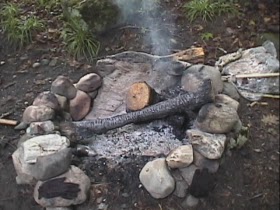BioChar… something old, it in a new form

Using ash as fertilizer isn’t anything new or unheard of as many older farm gardeners have used ash for years, I recall my 90 year old neighbor burning leaves each fall in her garden as a way to improve her soil. My mother emptied her wood burning stove and spread the ash in her garden each year, this is an old school practice and the explanation is a simple one.
Wood ash, created by burning plant materials using oxygen, has levels of potassium, calcium and magnesium carbonate/oxide that are available in large quantities, wood ash is very alkaline and neutralizes acid soils. Wood ash contains the elements of wood except nitrogen and sulfer as they are burned off during the fire process. It is best to have your soil tested to determine its alkalinity or acidity before application. The most common application of wood ash is 5- 10 pounds per 100 sq ft (done only once per year) which is raked in or scattered on freshly tilled soil approximately 3-5 weeks before planting. Ash can also be used as a side dressing or a deterrent to slugs and snails, you must be careful not to get ash on foliage as it can burn. Wood ash has very little nitrogen, you would need to supplement your fertilizing plan with nitrogen if using wood ash. When using ash you want your source to be free of chemical additives, you wouldn’t use ash from painted wood, pressure treated lumber or from chemically treated yards. To recap, ash is a product of burning plant material in open fires using oxygen, ash is high in many macronutrients and yet void of nitrogen and sulfur.
BioChar starts out from burning plant sources without oxygen, the result is a residue high in nitrogen. To use BioChar it has to be buried in the garden soil to be effective, you can add it to your planting medium or directly into the garden at a rate of 1 cup to 2 gallons of planting soil. BioChar has many advantages when used in the garden one of which being its ability to retain moisture, making it available to the plant when needed. Microbes in the earth like the oils in the charcoal, this stimulates microbe growth and stabilizes nutrients. Once buried, the BioChar also helps to neutralize soils, make the soil resistant to nematode, fungus and insects. BioChar replaces nitrogen oxide as a fertilizer, nitrogen oxide has many downfalls and has a greenhouse effect 300 times worse than carbon dioxide. To read a bit more on BioChar see this article in Mother Earth News. There is evidence of BioChar being used in ancient times to create the deep nutrient dense soils found deep in the Amazon. These soils pockets of rich soil called terra preta or “dark earth” were not just a creation of nature but instead an ancient practice using BioChar.
If I were to try this as a source of nitrogen I would use a local source, I have found Vermont BioChar, stay tuned to my gardening adventures in 2011 to see if this will be used in a trial plot. Making charcoal at home is a fairly technical process as you want to do it in such a way that you burn off the greenhouse gases before they can become harmful to the environment, this is something best left to the professionals. This is a piece of information I wanted to share with you hoping that you can see the two different fertilizers derived from the same source created in the same fashion, one with and one without oxygen. The concern with BioChar is that if its use becomes to prolific that the worlds forest would be pillaged even further to create more and more Biochar.
(okay this bit is off track but I wanted to include it for those who don’t understand the basis of fertilizer.)
Why is this so interesting, most commercial fertilizer has three numbers on the label indicating the level of the three primary macronutrients: nitrogen, phosphorous and potassium that the fertilizer contains. There are also secondary macronutrients as well in the form of calcium, sulfur and magnesium and trace minerals like boron, chlorine, manganese , iron , zinc , copper , molybdenum and selenium. Synthetic nitrogen, ammonium nitrate, is a regulated product due to its alternate use as an oxidizing agent in bombs. Ammonium nitrate is also used in cold packs, one cell holds water and the other hold ammonium nitrate. When the water is added the ammonium nitrate crystals dissolve and create a hypothermic effect and draws heat from the surround area which creates a cooling effect. Ammonium nitrate has been used in improvised explosive devices, was the main ingredient in the Oklahoma City bombing and has been involved in many catastrophic industrial accidents due to its volatility, yet it is used to grow bigger veggies for human consumption, doesn’t that sound yummy, NOT!
What are your thoughts on BioChar?
Pingback: BioChar Revisited